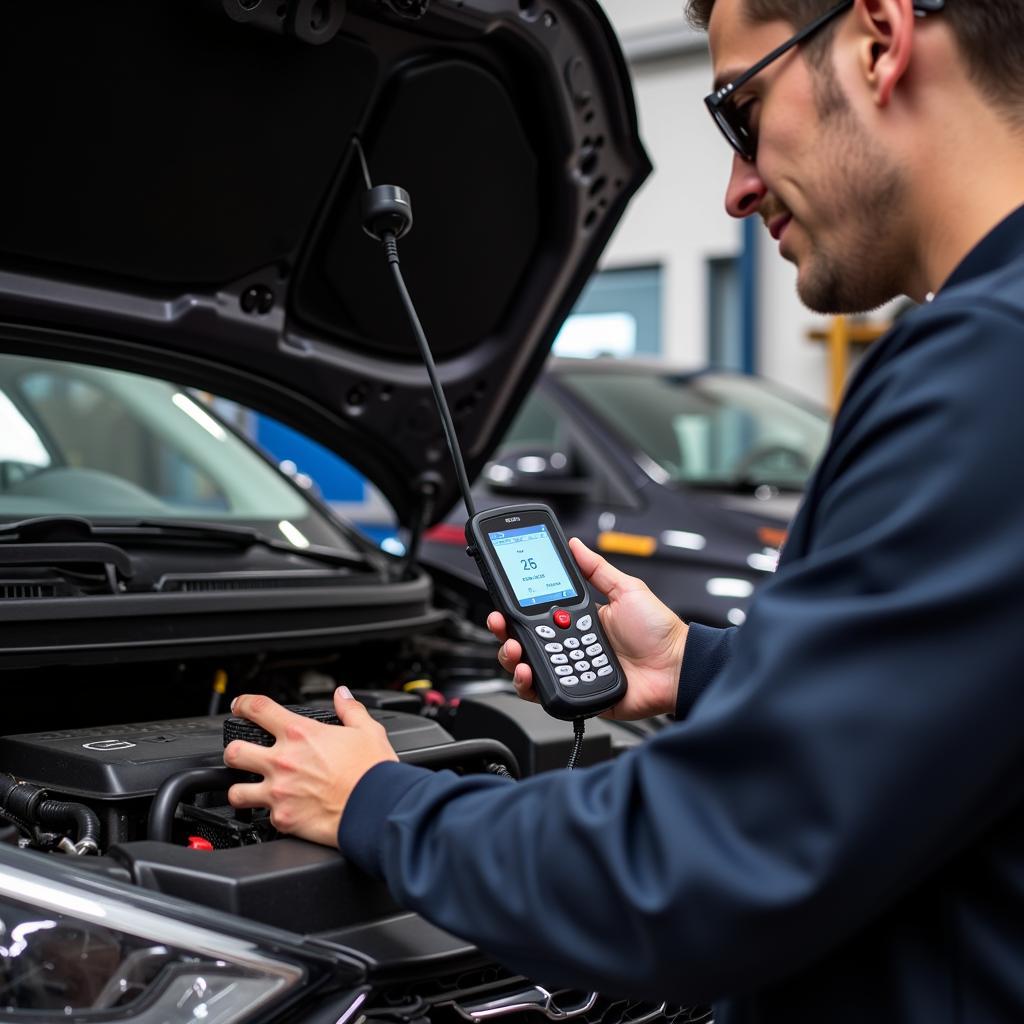Your cart is currently empty!

Hyundai i20 OBD2: Understanding Your Car’s Diagnostics
The Hyundai i20, a popular compact car known for its fuel efficiency and stylish design, utilizes the OBD2 (On-Board Diagnostics) system just like other modern vehicles. This system acts as your car’s built-in mechanic, constantly monitoring various systems and components for optimal performance. When an issue arises, the OBD2 system generates a specific code, illuminating the check engine light on your dashboard.
Accessing these codes requires an OBD2 scanner, a handy tool that allows you to “talk” to your i20’s computer and decipher the cryptic messages it sends. Understanding these codes is key to identifying the root cause of car troubles and taking the right steps towards a solution.
 Hyundai i20 OBD2 Port Location
Hyundai i20 OBD2 Port Location
Decoding the Hyundai i20 OBD2 System
The OBD2 system in your Hyundai i20 plays a crucial role in keeping your car running smoothly. Here’s a closer look at its functions:
- Monitoring Emissions: A primary function of OBD2 is to monitor your i20’s emissions system, ensuring it meets environmental standards. This includes monitoring components like the catalytic converter, oxygen sensors, and the evaporative emissions system.
- Detecting Engine Problems: The system continuously monitors critical engine parameters like air intake, fuel pressure, and ignition timing. Any deviations from normal operating ranges trigger an OBD2 code, signaling a potential engine problem.
- Troubleshooting Transmission Issues: Modern automatic transmissions in cars like the i20 are complex systems. The OBD2 system can pinpoint issues within the transmission control module (TCM) or sensors, aiding in accurate diagnosis and repair.
Why You Might Need a Hyundai i20 OBD2 Scanner
While the check engine light is a clear indicator of a potential issue, it doesn’t specify the problem. This is where an OBD2 scanner becomes essential. Here are common scenarios where an OBD2 scanner proves invaluable:
- Check Engine Light Illumination: An illuminated check engine light is a clear sign that your i20 needs attention. An OBD2 scanner reveals the specific code triggering the light, providing insights into the problem’s nature and severity.
- Troubleshooting Performance Issues: Experiencing rough idling, decreased fuel efficiency, or sluggish acceleration? An OBD2 scanner can help pinpoint the underlying cause by identifying sensor malfunctions, misfires, or other performance-related issues.
- DIY Maintenance and Repairs: For the mechanically inclined, an OBD2 scanner empowers you to diagnose and address minor issues yourself, potentially saving you trips to the mechanic and costly repair bills.
Choosing the Right Hyundai i20 OBD2 Scanner
Navigating the world of OBD2 scanners can feel overwhelming with countless options available. Here are key factors to consider when choosing the right scanner for your i20:
- Compatibility: Ensure the scanner you choose is compatible with your i20’s model year. Most scanners work across a wide range of vehicles, but double-checking compatibility is crucial.
- Functionality: Scanners offer varying levels of functionality. Basic scanners read and clear codes, while more advanced models offer live data streaming, graphing capabilities, and even specific manufacturer-level diagnostics for Hyundai vehicles.
- Budget and Features: OBD2 scanners come in a wide price range, from budget-friendly options to professional-grade tools. Consider your budget and the features that align with your needs and technical expertise.
Common Hyundai i20 OBD2 Codes
While countless OBD2 codes can appear, some are more prevalent in Hyundai i20s. Understanding these common codes can give you a head start in troubleshooting:
- P0420 – Catalyst System Efficiency Below Threshold (Bank 1): This code often indicates a failing catalytic converter, a crucial component of the emissions system.
- P0171 – System Too Lean (Bank 1): This code suggests the engine is running lean, meaning there’s too much air compared to fuel. Potential causes include a vacuum leak, faulty oxygen sensor, or fuel delivery problem.
- P0300 – Random/Multiple Cylinder Misfire Detected: As the code suggests, this indicates engine misfires, which can lead to rough idling, power loss, and increased emissions. Spark plugs, ignition coils, or fuel injectors are common culprits.
Expert Insights
“Investing in a quality OBD2 scanner for your Hyundai i20 is a smart move,” says automotive expert [Expert Name], lead mechanic at [Workshop Name]. “Not only can it save you money on unnecessary mechanic visits, but it also empowers you to stay on top of your car’s health and address minor issues proactively.”
 Mechanic Diagnosing Hyundai i20 Engine Bay
Mechanic Diagnosing Hyundai i20 Engine Bay
Conclusion
Your Hyundai i20’s OBD2 system is a powerful tool for maintaining your vehicle’s health and performance. By understanding how to utilize an OBD2 scanner, you can gain valuable insights into your car’s inner workings and take proactive steps to address potential issues. Whether you’re a seasoned DIYer or simply want to be more informed about your vehicle, a Hyundai I20 Obd2 scanner is a valuable investment.

Leave a Reply